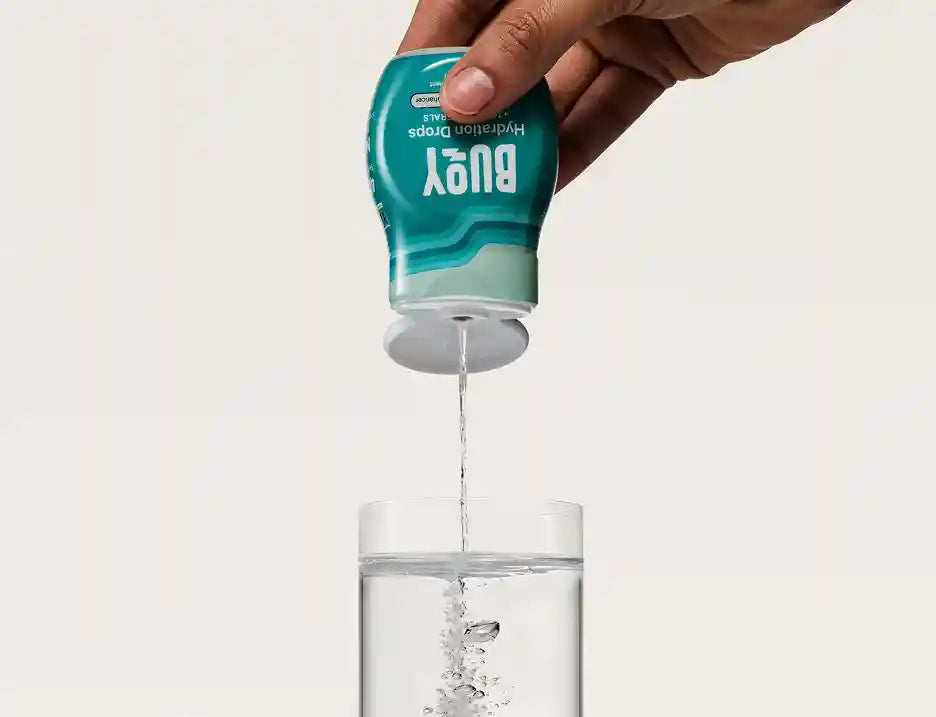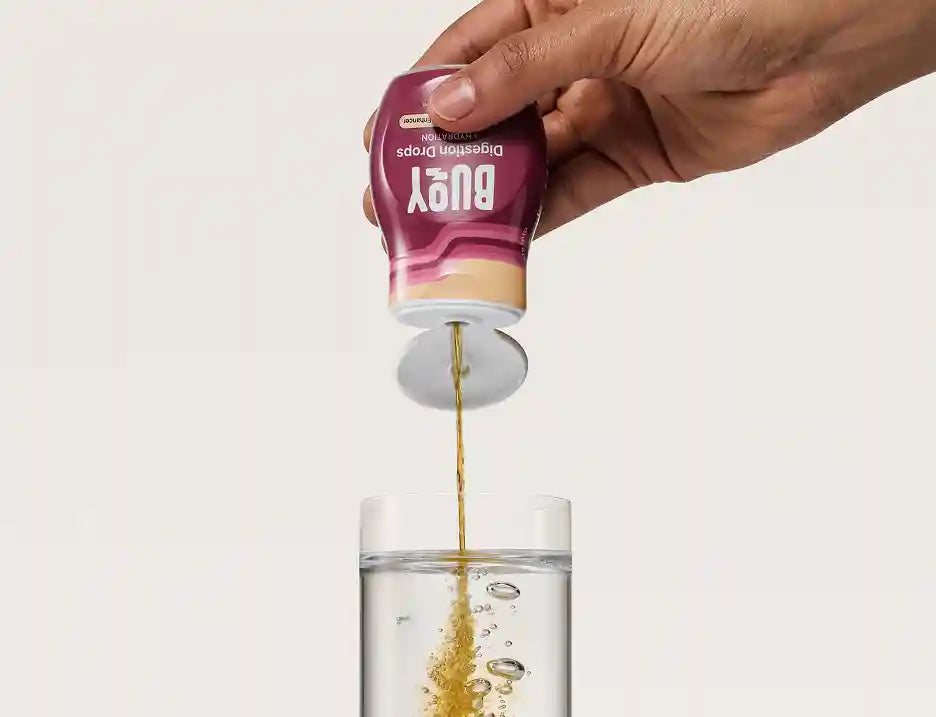
Hydration Tips for POTS: Stay Hydrated and Manage Your Symptoms
For those living with Postural Orthostatic Tachycardia Syndrome (POTS), staying hydrated is essential. Why? Because proper hydration, combined with balanced electrolytes, can significantly reduce your POTS symptoms, including especially debilitating ones like dizziness, fatigue, and fainting episodes.
Essential Takeaways:
- Hydration is Crucial for Managing POTS:. Maintaining proper hydration helps significantly reduce debilitating POTS symptoms like dizziness, fatigue, and fainting. Drinking enough water throughout the day can stabilize blood volume and reduce episodes of low blood pressure, which are common in POTS.
- Electrolyte Balance is Key: Optimizing your hydration goes beyond just drinking water. Make daily hydration easier with premium hydration solutions like Buoy’s Rescue Drops, which are specially formulated for POTS with 6x the sodium in Hydration Drops.
In this guide, we’ll look at some practical hydration strategies tailored specifically for POTS. Are you ready to learn more? Let’s get started!
- Why Hydration is Key in Managing POTS
- Daily Hydration Goals for POTS Patients
- Best Hydration Practices: What Works and What Doesn’t
- The Role of Electrolytes in Hydration
- Hydration Myths: What You Should Avoid
- Stay Hydrated, Stay Strong
Why Hydration is Key in Managing POTS
For people with Postural Orthostatic Tachycardia Syndrome, hydration isn’t just about quenching thirst—it’s essential for managing symptoms. Let’s explore why hydration is even more important for people with POTS.
Blood Volume Regulation
POTS often causes low blood volume, which can worsen symptoms. Proper hydration helps increase blood volume, making it easier for your body to maintain adequate blood flow, especially when changing positions.
Blood Pressure Stabilization
Adequate hydration supports better blood pressure control. This is crucial for people with POTS who experience drops in blood pressure upon standing, which can lead to dizziness and fainting.
Heart Rate Control
By improving blood volume and circulation, good hydration can help reduce the rapid heart rate often experienced by POTS patients when standing.
Symptom Reduction
Staying well-hydrated can significantly reduce the severity of POTS symptoms like fatigue, brain fog, and exercise intolerance.
Electrolyte Balance
Proper hydration, especially when combined with adequate electrolyte intake, helps maintain the delicate balance of minerals in your body necessary for optimal nerve and muscle function.
The Bottom Line
Of course, hydration alone isn’t a cure for POTS, but it’s a powerful tool in your symptom management toolkit. Combined with other treatments and lifestyle changes, proper hydration can greatly improve daily functioning (1,2).
Want to learn more about managing your POTS symptoms? Get Expert Tips on Managing POTS Symptoms.
Daily Hydration Goals for POTS Patients
Understanding hydration for POTS is essential for managing symptoms effectively. Here are some general guidelines for daily fluid intake:
- Base Recommendation: Aim for 2-3 liters (about 8.5-12.5 cups or 68-101 ounces) of fluids per day. This is higher than the recommendation for the general population due to the specific needs of people with POTS.
- Weight-Based Calculation: A more personalized approach is to drink about 0.5 ounces of fluid per pound of body weight. For example, a 150 pound person would aim for about 9.4 cups (75 ounces) per day.
- Activity Level Adjustment: Increase your fluid intake on days with more physical activity or in hot weather. You might need an additional 2-4 cups (16-32 ounces) on these days.
- Climate Considerations: If you live in a hot or humid climate, you may need to increase your fluid intake even more.
- Electrolyte Balance: Remember that it’s not just about your fluid intake. Add a squeeze of Buoy to the beverages you already drink to maintain optimal electrolyte balance throughout the day. We recommend 4-7 times per day to meet your increased sodium needs with POTS.
- Timing Matters: Try to spread out your fluid intake throughout the day rather than consuming large amounts at once, which can be challenging for some POTS patients. Aim for about 1 cup (8 ounces) of fluid every hour you’re awake.
- Listen to Your Body: Pay attention to your thirst and urine color. Aim for a pale yellow color as an indicator of good hydration. If your urine is dark or you feel thirsty, it’s time to drink more fluids (1,2).
Always consult with your healthcare provider to determine the ideal hydration plan for your specific needs. They may recommend adjustments to these basic guidelines based on your individual symptoms, medications, and overall health status.

Infuse your water with fresh fruits like watermelon, lemon, or berries to add a refreshing taste and make hydration easier.
Best Hydration Practices: What Works and What Doesn’t
Staying hydrated with POTS can be challenging, but it’s crucial for managing symptoms. Let’s explore some effective strategies to help you maintain optimal hydration throughout the day, as well as some practices to avoid.
What Works:
When you have POTS, staying hydrated requires a strategic approach. Here are some effective practices that can help you maintain optimal hydration every day:
-
Start Your Day with Water: Kick off your morning by drinking a glass of water. This simple habit can jumpstart your hydration for the day and help replenish fluids lost overnight.
-
Carry a Water Bottle: Keep water with you throughout the day by carrying a reusable water bottle. This visual reminder can help you sip consistently rather than trying to drink large amounts at once, which can be challenging for some people with POTS.
-
Set Reminders: Use your phone’s alarm or a hydration app to remind you to drink water regularly. These prompts can be especially helpful if you tend to get caught up in daily activities and forget to hydrate.
-
Infuse Your Water: Plain water can get boring, making it harder to reach your hydration goals. Try infusing your water with fruits like lemon or berries, or vegetables like cucumber, to add flavor without adding sugars or artificial sweeteners.
-
Add Electrolytes: Make Buoy’s electrolyte and mineral drops part of your daily routine. These can help you maintain proper electrolyte balance, which is crucial for maintaining optimal hydration and managing POTS symptoms.
-
Eat Water-Rich Foods: Include foods with high water content in your diet, such as watermelon, cucumbers, soups, and smoothies. These can contribute to your overall fluid intake.
- Track Your Intake: Keep a hydration journal or use a smartphone app to log your daily fluid intake. This can help you ensure you’re meeting your hydration goals.
These tips for staying hydrated with POTS can help you maintain optimal hydration throughout the day.
What Doesn’t Work:
While staying hydrated is essential for managing POTS, not all hydration practices are beneficial for this condition. In fact, some common habits that work for the general public can actually worsen your symptoms and lead to other health issues.
Here are some practices you should avoid in your hydration routine:
-
Relying on Thirst Alone: Don’t wait until you feel thirsty to drink water. By the time you feel thirsty, you may already be mildly dehydrated. Try to drink regularly throughout the day—about 1 cup most hours you’re awake.
-
Overhydrating with Plain Water: While staying hydrated is important, drinking excessive amounts of plain water without balancing electrolytes can lead to hyponatremia, a dangerous condition where sodium levels in the blood become too low. The solution? Add a squeeze of Buoy drops or a pinch of Buoy’s Rescue Salt to your drinks about 4-7 times throughout the day.
-
Drinking Caffeinated Beverages - Know Your Limits: Caffeine affects everyone differently, and that’s especially true for people with POTS. While some may find that caffeine worsens their symptoms, others tolerate small amounts without issue.
If you drink caffeinated beverages like coffee or tea, it’s important to monitor how your body responds. Caffeine can have a mild diuretic effect in some individuals, potentially increasing fluid loss—but for many people, especially habitual users, this effect is negligible.
Instead of cutting out caffeine entirely, focus on balance. Pair caffeinated drinks with extra water and electrolytes to help offset any potential fluid loss. Buoy’s Rescue Drops or a pinch of Rescue Salt can help you maintain that balance.
Tip: If you’re unsure whether caffeine affects your POTS symptoms, try reducing your intake gradually while keeping a symptom journal. This can help you make more informed decisions based on your personal experience.
-
Consuming Alcohol: Alcohol is dehydrating and can exacerbate POTS symptoms. It’s best to avoid or strictly limit alcohol consumption.
- Drinking Ice-Cold Water: Very cold water can sometimes trigger symptoms in people with POTS. Opt for room temperature or slightly cool water instead.
Everyone’s body is different, and what works for one person with POTS may not work for another. It’s important to listen to your body and consult your healthcare provider to develop a hydration plan that’s tailored to your specific needs and symptoms.
Discover essential tools and products to improve everyday living with POTS in our guide to Recommended Products for POTS.
The Role of Electrolytes in Hydration
For people with Postural Orthostatic Tachycardia Syndrome (POTS), proper hydration goes beyond just drinking water. Maintaining the right balance of electrolytes, particularly sodium and potassium, is crucial for managing symptoms and overall health.
Why Electrolytes Matter
Electrolytes are minerals in your blood and other bodily fluids that carry an electric charge. They play important roles in several body processes, including regulating nerve and muscle function, hydrating your body, balancing blood acidity and pressure, and helping rebuild damaged tissue.
Key Electrolytes for POTS
Understanding the role of specific electrolytes is crucial for effective POTS management. While all electrolytes play important roles in body function, some are particularly essential for POTS patients. Let’s explore the key players:
- Sodium: This is perhaps the most critical electrolyte for people with POTS. Increased sodium intake can help boost blood volume and improve symptoms. Many POTS patients are advised to increase their daily sodium intake to ½ to 1 ½ teaspoons (or 3-10 grams) of salt per day under medical supervision. Consult with your doctor to determine the right amount for you.
- Potassium: This electrolyte works with sodium to regulate fluid balance and nerve signals, and it’s essential for proper heart function.
- Magnesium: This mineral helps regulate muscle and nerve function, blood sugar levels, and blood pressure.
- Calcium: This electrolyte is important for muscle function, including the heart muscle, as well as strong bones and teeth.
Balancing these key electrolytes is crucial for managing POTS symptoms effectively. However, it’s important to remember that electrolyte needs can vary from person to person.
Always work closely with your healthcare provider to develop an electrolyte strategy that’s tailored to your individual needs and monitor your levels regularly to ensure optimal balance.
POTS-Friendly Electrolyte Sources
To maintain proper electrolyte balance, consider the following options:
- Electrolyte Drinks: Look for beverages specifically formulated for POTS. These often contain higher levels of sodium than regular sports drinks.
- Electrolyte Supplements: Buoy’s Rescue Drops were specifically designed to help manage POTS, offering a concentrated source of electrolytes and 6x the sodium of our Hydration Drops. And they are purposely unflavored, so you can add them to any beverage.
- High-Quality Salt: Part of our Rescue Line, which was formulated with POTS in mind, Buoy’s Rescue Salt dissolves quickly on your tongue or in any beverage, providing fast-acting boosts to energy, gut health, brain function, and skin health. The ionic form of the minerals makes the High Bioavailability than typical salt supplements.
- Coconut Water: A natural source of electrolytes, especially potassium.
- Electrolyte-Rich Foods: Include foods like bananas (potassium), pickles (sodium), and leafy greens (magnesium) in your diet.
By focusing on both hydration and electrolyte balance, you can create a more effective strategy for managing your POTS symptoms and improving your overall quality of life (3,4).

Hydration Myths: What You Should Avoid
When it comes to hydration for POTS, there are several common misconceptions that can actually worsen symptoms or lead to other health issues. Let’s debunk these myths and discuss what you should do instead.
Myth 1: More Water is Always Better
While staying hydrated is crucial for people with POTS, drinking excessive amounts of plain water without balancing electrolytes can be counterproductive and even dangerous.
1. Why It’s a Myth: Drinking too much plain water can cause hyponatremia, a condition where sodium levels in the blood become dangerously low. This can worsen POTS symptoms and cause additional health problems.
2. What to Do Instead: Balance your water intake with electrolytes. Add Buoy’s Rescue Drops or a pinch of Buoy’s Rescue Salt to your water 4-7 times throughout the day to maintain proper electrolyte levels.
Myth 2: Thirst is a Reliable Indicator of Hydration Needs
Many people believe they should only drink fluids when they feel thirsty.
1. Why It’s a Myth: Waiting until you feel thirsty can lead to dehydration, especially for those with POTS. By the time you feel thirsty, you may already be mildly dehydrated.
2. What to Do Instead: Develop a consistent hydration routine. Aim to drink about 1 cup of water most hours you’re awake, regardless of thirst. Use reminders if necessary to stay on track by setting alarms on your phone or using a hydration app.
Myth 3: Caffeine is a Good Hydration Source
Some people rely on caffeinated beverages like coffee (including decaf) or energy drinks for hydration and an energy boost, thinking it’s just as good for hydration as other fluids like water or coconut water.
1. Why It’s a Myth: While caffeine can provide a temporary boost of energy, it’s also a diuretic that can lead to increased fluid loss. For many people with POTS, caffeine can worsen symptoms by increasing their heart rate and potentially triggering episodes.
Even decaffeinated coffee contains small amounts of caffeine and can have mild diuretic effects.
2. What to Do Instead: It’s best to limit or avoid caffeinated drinks, including regular and decaf coffee. If you consume caffeine, balance it with extra water and electrolytes. Pay close attention to how your body responds and adjust accordingly.
Consider caffeine-free alternatives for energy, such as proper hydration, balanced nutrition, and POTS-friendly energy-boosting strategies recommended by your healthcare provider.
Myth 4: Sports Drinks are the Best Option for Electrolyte Replacement
Many people turn to sports drinks to replace their electrolytes.
1. Why It’s a Myth: While sports drinks do contain electrolytes, they’re often not formulated specifically for the needs of people with POTS. Many contain high amounts of sugar and other additives that may actually worsen POTS symptoms, and they may not have the optimal balance of electrolytes needed for POTS management.
2. What to Do Instead: Choose electrolytes specifically formulated for POTS like Buoy’s Rescue Drops. These provide a more appropriate balance of electrolytes without unnecessary sugars or artificial ingredients. Plus, they’re purposely unflavored, so you can turn any beverage into an electrolyte-balancing drink.
Myth 5: Ice-Cold Water is Best for Hydration
Some believe that very cold water is more refreshing and therefore better for hydration.
1. Why It’s a Myth: For many POTS patients, consuming ice-cold beverages can trigger or worsen symptoms. Cold temperatures can cause blood vessels to constrict, potentially exacerbating circulation issues.
2. What to Do Instead: Opt for room temperature or slightly cool water. This can be easier for your body to absorb and less likely to trigger POTS symptoms.
Everyone’s body is different, and what works for one person with POTS might not work for another. It’s important to work closely with your healthcare provider to develop a hydration strategy that’s tailored to your specific needs and symptoms.
By avoiding these common hydration myths and focusing on balanced, POTS-friendly hydration practices, you can more effectively manage your symptoms and improve your overall quality of life.
Stay Hydrated, Stay Strong
Living with POTS can be challenging, but proper hydration can be a powerful tool in your symptom management toolkit. Incorporating these hydration tips into your daily routine can help you manage your POTS more effectively and improve your quality of life.
The Power of Consistency
Small, sustainable changes in your hydration habits can lead to big improvements over time. Whether it’s carrying a water bottle with you, setting hydration reminders, or adding electrolyte-rich foods and supplements to your diet, every effort counts.
Buoy's Rescue Line: Your POTS Hydration Ally
To make your hydration journey easier and more effective, consider trying Buoy’s Rescue Line, specially formulated products for POTS management:
- Buoy Rescue Drops: These concentrated electrolyte drops were designed with POTS in mind, offering 6x the sodium of our regular Hydration Drops. They’re purposely unflavored, so you can add them to any beverage for an electrolyte boost.
- Buoy Rescue Salt: This high-quality, fast-dissolving salt provides a quick and easy way to increase your sodium intake, along with other beneficial minerals.
By incorporating these products into your hydration routine, you can ensure you’re getting the right balance of electrolytes to support your POTS management.
Explore More POTS Resources
Want to learn more about managing POTS? Check out our other POTS guides for more tips and strategies on nutrition, exercise, and living well with this condition. We’re here to support you every step of the way.
A Holistic Approach to POTS Management
Remember, while hydration is important, it’s just one part of a comprehensive POTS management plan. Always work closely with your healthcare provider to develop a strategy that’s tailored to your individual needs.
Stay hydrated, stay informed, and stay strong. With the right tools and knowledge, you can take control of your symptoms and even thrive with POTS!

References:
-
Johns Hopkins Medicine. (n.d.). Postural Orthostatic Tachycardia Syndrome (POTS). Retrieved from https://www.hopkinsmedicine.org/health/conditions-and-diseases/postural-orthostatic-tachycardia-syndrome-pots
-
Cleveland Clinic. (2022). Postural Orthostatic Tachycardia Syndrome (POTS). Retrieved from https://my.clevelandclinic.org/health/diseases/16560-postural-orthostatic-tachycardia-syndrome-pots
-
Healthline. (2019). Electrolytes: Functions, Imbalance, and Sources. Retrieved from https://www.healthline.com/nutrition/electrolytes
- EDS Nutrition. Electrolytes for POTS and Dysautonomia: A Comprehensive Guide. Retrieved from https://edsnutrition.com/electrolytes-for-pots-guide/





